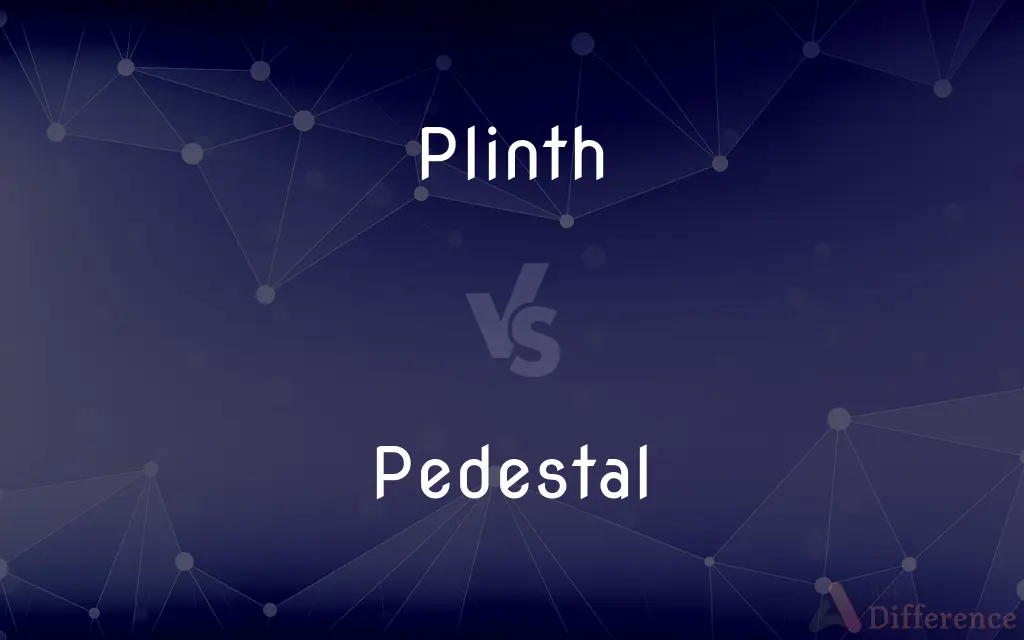Plinth vs. Pedestal — What's the Difference?
By Tayyaba Rehman & Maham Liaqat — Updated on March 18, 2024
A plinth is the base or platform upon which a statue, column, or structure rests, often part of the structure itself, while a pedestal is a support or base for a statue, vase, or column, usually distinct from the object it supports.

Difference Between Plinth and Pedestal
Table of Contents
ADVERTISEMENT
Key Differences
Plinths serve as the lowermost members of a structure, often merging seamlessly with the object they support, such as the base of a statue or the bottom part of a building's facade. They provide stability and elevate the structure slightly above its surroundings, protecting it from moisture and wear. Pedestals, on the other hand, are more defined and separate supports that elevate and display objects like sculptures, vases, or urns. They consist of a base, a vertical shaft, and a top (or cap), and are designed to complement the aesthetics of the object they hold, enhancing its visibility and importance.
While plinths can be simple and functional, integrating with the overall design of the structure, pedestals are often ornamental and crafted to stand out as part of the display. In architecture, a plinth may refer to the base course of stones at the building's foundation, providing a strong platform for the structure's weight. In contrast, a pedestal in a gallery or museum setting is designed to isolate the displayed object from its environment, focusing the viewer's attention on the art.
Plinths are commonly used in architecture as part of the structure itself, extending its presence to the ground level and sometimes blending with the floor or foundation. Pedestals, however, are more versatile and can be found in various settings, from interior design to public parks, where they serve both a functional and aesthetic role in presenting art or decorative objects.
Despite their differences, both plinths and pedestals elevate the objects or structures they support, enhancing their stature and prominence. The choice between a plinth and a pedestal often depends on the context and desired effect, with plinths providing a more integrated and subtle elevation, while pedestals offer a distinct and often more dramatic display.
Comparison Chart
Definition
The base or platform of a structure
A support or base for displaying objects
ADVERTISEMENT
Integration
Often merges with the structure
Distinct from the object it supports
Composition
Can be simple or part of the structure
Consists of base, shaft, and cap
Function
Provides stability, elevation
Elevates, displays, and enhances objects
Usage
Architecture, structural bases
Display of art, sculpture, decorative items
Aesthetics
Functional, integrating with design
Ornamental, crafted to complement object
Compare with Definitions
Plinth
The base supporting a statue or column, often part of the structure.
The ancient statue stood firmly on its stone plinth.
Pedestal
A base or stand that elevates and displays objects like sculptures.
The bronze bust was prominently displayed on a pedestal in the gallery.
Plinth
A structural element separating the ground from the building's base.
The museum's facade featured a marble plinth at its foundation.
Pedestal
Consists of a base, shaft, and top, often ornamental.
The intricately carved pedestal added elegance to the vase it supported.
Plinth
Integrates with the overall design of a structure.
The plinth at the building's entrance matched its architectural style.
Pedestal
Versatile in application, from interior design to public spaces.
The modern sculpture was mounted on a sleek, minimalist pedestal in the lobby.
Plinth
Used to elevate structures for protection and stability.
The plinth raised the wooden cabin above the flood-prone ground.
Pedestal
Used to focus attention on the object it holds.
The statue of the hero stood on a pedestal in the town square, drawing the eyes of passersby.
Plinth
Can be functional, emphasizing stability and support.
The plinth under the sculpture ensured its secure placement in the garden.
Pedestal
Enhances the aesthetic presentation of decorative items.
The antique urn was set upon a pedestal, highlighting its craftsmanship.
Plinth
A block or slab on which a pedestal, column, or statue is placed.
Pedestal
A pedestal (from French piédestal, Italian piedistallo 'foot of a stall') or plinth is the support of a statue or a vase, and of a column in architecture. Smaller pedestals, especially if round in shape, may be called socles.
Plinth
The base block at the intersection of the baseboard and the vertical trim around an opening.
Pedestal
An architectural support or base, as for a column or statue.
Plinth
A continuous course of stones supporting a wall. Also called plinth course.
Pedestal
A support or foundation.
Plinth
A square base, as for a vase.
Pedestal
A position of high regard or adoration.
Plinth
A block or slab upon which a column, pedestal, statue or other structure is based.
Pedestal
To place on or provide with a pedestal.
Plinth
The bottom course of stones or bricks supporting a wall.
Pedestal
(architecture) The base or foot of a column, statue, vase, lamp.
Plinth
A base or pedestal beneath a cabinet.
Pedestal
(figuratively) A place of reverence or honor.
He has put his mother on a pedestal. You can't say a word against her.
Plinth
In classical architecture, a vertically faced member immediately below the circular base of a column; also, the lowest member of a pedestal; hence, in general, the lowest member of a base; a sub-base; a block upon which the moldings of an architrave or trim are stopped at the bottom. See Illust. of Column.
Pedestal
(rail transport) A casting secured to the frame of a truck of a railcar and forming a jaw for holding a journal box.
Plinth
An architectural support or base (as for a column or statue)
Pedestal
(machining) A pillow block; a low housing.
Pedestal
(bridge building) An iron socket, or support, for the foot of a brace at the end of a truss where it rests on a pier.
Pedestal
(steam heating) a pedestal coil, group of connected straight pipes arranged side by side and one above another, used in a radiator.
Pedestal
(telecommunications) A ground-level housing for a passive connection point for underground cables.
Pedestal
(electronics) The measured value when no input signal is given.
Pedestal
(aviation) The central part of the cockpit, between the pilots, where various controls are located.
Pedestal
The tough protuberant pad covering a dromedary's sternum, which, when the camel lies down, causes the abdomen to be slightly above the hot ground.
Pedestal
To set or support on (or as if on) a pedestal.
Pedestal
The base or foot of a column, statue, vase, lamp, or the like; the part on which an upright work stands. It consists of three parts, the base, the die or dado, and the cornice or surbase molding. See Illust. of Column.
Build him a pedestal, and say, "Stand there!"
Pedestal
A short free-standing column or column-like object designed to support a work of art or other object; a column serving the same function as the base of a statue. It may be made of wood, marble, or other suitable material.
Pedestal
A part of a desk which contains a frame and drawers, stands on the floor, and provides support for the desk surface. There may be zero, one, or two such pedestals in a desk.
Pedestal
A casting secured to the frame of a truck and forming a jaw for holding a journal box.
Pedestal
A support or foundation;
The base of the lamp
Pedestal
A position of great esteem (and supposed superiority);
They put him on a pedestal
Pedestal
An architectural support or base (as for a column or statue)
Common Curiosities
Are plinths only used outdoors?
Plinths are used both outdoors and indoors, depending on the architectural design and the need for elevation or separation from the ground.
Can a plinth be considered a type of pedestal?
While a plinth can function similarly to a pedestal by elevating and supporting, it is generally more integrated with the structure it supports and less ornamental.
Can any object be placed on a pedestal?
Technically, any object can be placed on a pedestal, but pedestals are typically used for objects of importance or beauty, such as art, to highlight their value.
How does the design of a pedestal affect the displayed object?
The design of a pedestal can greatly enhance the visibility and aesthetic appeal of the object it displays, drawing attention and complementing its style.
How do you choose between a plinth and a pedestal for displaying an object?
The choice depends on the context and desired effect; a plinth offers a more integrated elevation, while a pedestal provides a distinct and often more dramatic display.
Can the use of a plinth or pedestal affect the perception of an object or structure?
Yes, both plinths and pedestals elevate and thereby enhance the stature and prominence of the objects or structures they support, affecting how they are perceived.
Is it common for buildings to have plinths?
Many buildings, especially those with classical or traditional designs, feature plinths as part of their architectural base, providing stability and aesthetic continuity.
Are pedestals always ornate?
While pedestals are often ornamental, their design can range from intricate and classical to simple and modern, depending on the setting and the object they support.
How are pedestals adapted for different environments?
Pedestals are designed with materials and styles that suit their environment, from weather-resistant outdoor pedestals to elegant indoor versions that complement interior decor.
What considerations are important when designing a plinth for a structure?
When designing a plinth, considerations include the weight and dimensions of the structure, material compatibility, environmental factors, and aesthetic integration with the overall design.
Share Your Discovery

Previous Comparison
English vs. Spin
Next Comparison
Sprat vs. WhitebaitAuthor Spotlight
Written by
Tayyaba RehmanTayyaba Rehman is a distinguished writer, currently serving as a primary contributor to askdifference.com. As a researcher in semantics and etymology, Tayyaba's passion for the complexity of languages and their distinctions has found a perfect home on the platform. Tayyaba delves into the intricacies of language, distinguishing between commonly confused words and phrases, thereby providing clarity for readers worldwide.
Co-written by
Maham Liaqat














































